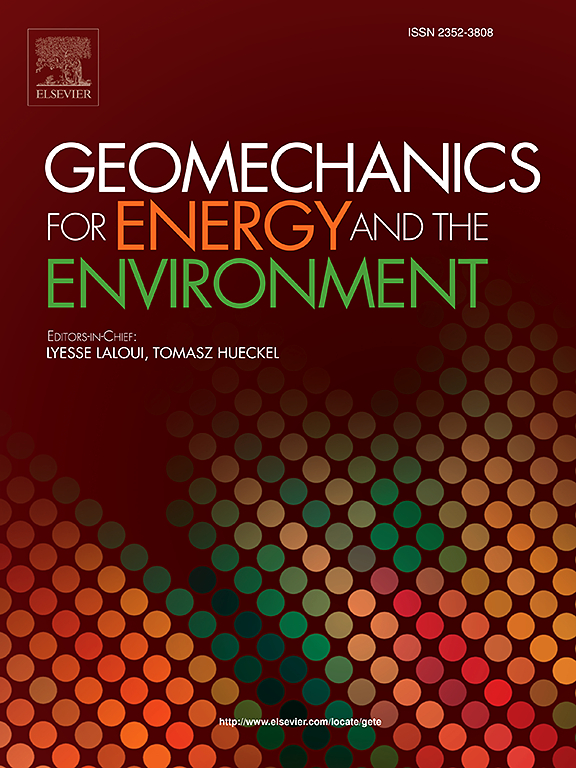GMZ膨润土球团/块团在水化作用下的水力学和均质行为
IF 3.7
2区 工程技术
Q3 ENERGY & FUELS
引用次数: 0
摘要
利用膨润土球团和膨润土块体共同构建地质储库工程屏障体系。膨润土颗粒/块体组件的水力学行为和均质化对储存库的长期运行安全具有重要意义。本研究将高庙子(GMZ)膨润土球团与不同初始干密度的块体组合成三种类型(I、II和III),并在等时程条件下进行水化。测量了轴向和侧向膨胀压力以及局部含水量和干密度的演变。采用x射线μCT和压汞孔隙测定(MIP)技术对不同水化时间下试样的孔隙结构进行了检测和分析。结果表明,轴向和侧向膨胀压力的发展模式和最终值与块体的组合类型和初始干密度密切相关。受壁面摩擦和织物各向异性的影响,颗粒侧最终侧胀压力高于块体侧,最终轴向膨胀压力介于两者之间。由于在试样底部附近最初形成的一层薄的膨润土凝胶限制了水分的可用性,并且颗粒间的孔隙逐渐被膨胀的颗粒所封闭,三种组合类型之间的入渗速率没有显著差异。对于所有三种组合类型,在初始水化阶段(>;72 h),球团区被膨胀块区压缩,球团/块界面倾向于向球团一侧弯曲/移动,导致球团重排,球团间孔隙关闭,界面愈合,从而使试样均匀化。采用相对孔隙度均质指数(RPHI)定量评价均质程度随水化时间的增加而降低。然而,即使在完全饱和后,残余的非均质性仍然存在,表明均质化将长期存在。本文章由计算机程序翻译,如有差异,请以英文原文为准。
Hydro-mechanical and homogenization behaviour of GMZ bentonite pellets/block assemblies upon hydration
Bentonite pellets and block are jointly used to construct engineered barrier systems in geological repository. The hydro-mechanical behavior and homogenizations of bentonite pellets/block assemblies are of significant concern to the long-term operational safety of the repository. In this study, Gaomiaozi (GMZ) bentonite pellets were combined with block of different initial dry densities in three types of assemblies (I, II and III) and subjected to hydration under isochoric conditions. Evolutions of axial and lateral swelling pressures as well as local water contents and dry densities were measured. The pore structures of specimens after different durations of hydration were detected and analyzed with resort to X-ray μCT and mercury intrusion porosimetry (MIP) techniques. Results show that, the development modes and final values of axial and lateral swelling pressures were highly dependent on the assembly type and the initial dry density of the block. Affected by wall friction and fabric anisotropy, the final lateral swelling pressure on the pellets side was higher than that on the block side and the final axial swelling pressure was in between. No significant water infiltration rate difference was observed among the three assembly types, due to water availability was limited by a thin layer of bentonite gels initially formed near to the specimen bottom and the inter-pellet pores were closed gradually by the swelling pellets. For all the three assembly types, after an initial hydration stage (> 72 h), the pellets zone was compressed by the swelling block zone and the pellets/block interface tended to bend/move towards the pellets side, leading to a rearrangement of pellets, closing of the inter-pellet pores, healing of the interface and thus homogenization of the specimen. The degree of homogenization was evaluated quantitatively to decrease with increasing hydration time using a relatively porosity homogenization index (RPHI). However, the residual heterogeneity still remained even after full saturation, indicating the homogenization will persist for a long term.
求助全文
通过发布文献求助,成功后即可免费获取论文全文。
去求助
来源期刊

Geomechanics for Energy and the Environment
Earth and Planetary Sciences-Geotechnical Engineering and Engineering Geology
CiteScore
5.90
自引率
11.80%
发文量
87
期刊介绍:
The aim of the Journal is to publish research results of the highest quality and of lasting importance on the subject of geomechanics, with the focus on applications to geological energy production and storage, and the interaction of soils and rocks with the natural and engineered environment. Special attention is given to concepts and developments of new energy geotechnologies that comprise intrinsic mechanisms protecting the environment against a potential engineering induced damage, hence warranting sustainable usage of energy resources.
The scope of the journal is broad, including fundamental concepts in geomechanics and mechanics of porous media, the experiments and analysis of novel phenomena and applications. Of special interest are issues resulting from coupling of particular physics, chemistry and biology of external forcings, as well as of pore fluid/gas and minerals to the solid mechanics of the medium skeleton and pore fluid mechanics. The multi-scale and inter-scale interactions between the phenomena and the behavior representations are also of particular interest. Contributions to general theoretical approach to these issues, but of potential reference to geomechanics in its context of energy and the environment are also most welcome.
 求助内容:
求助内容: 应助结果提醒方式:
应助结果提醒方式:


